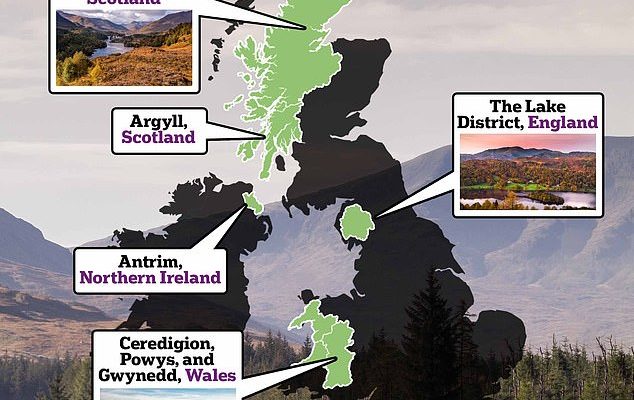While they may be all but lost, Britain is hiding a habitat you might never have expected to find on this cold island.
As these stunning maps reveal, the UK is home to one of the world’s rarest ecosystems: the temperate rainforest.
Although it might seem unlikely, the west coast of Britain is actually one of the few places where these beautiful landscapes can prosper.
While they could have once covered as much as 20 per cent of the country, they now only exist in scattered fragments.
However, all is not lost, as experts say that there is still a chance to save Britain’s hidden rainforests.
The UK is home to some of the world’s rarest rainforests but only fragments remain scattered across the country from Devon in England to the Highlands of Scotland
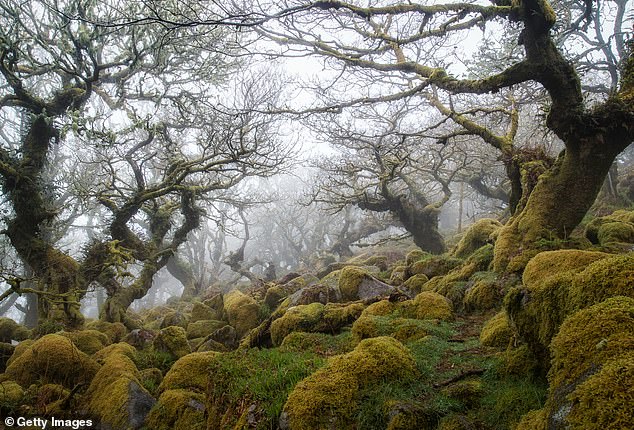
Temperate rainforests like this woodland in Dartmoor National Park are defined by persistent high humidity and cold conditions
The UK’s temperate rainforests are instantly recognisable for their twisted oaks and hanging mosses.
But what really sets them apart from other woodlands is water.
Dr Christopher Ellis, an ecologist and lichenologist from the Royal Botanic Garden Edinburgh told MailOnline: ‘Most people will be familiar with tropical rainforests that occur in a hot and moist climate.
‘Temperate rainforests are forests and woodlands that occur in a cool and consistently moist climate, and this includes the type of climate we have along the western side of Britain where we find our own temperate rainforest.’
These fragments extend from the coast of Cornwall and Devon in the South, up through Wales and North into the Scottish Highlands.
All that water makes these cold rainforests the perfect home for types of plants called Ectophytes which include mosses and lichens.
Stan Smith, Atlantic Rainforests programme manager at the Wildlife Trust, told MailOnline that the way to think of these areas was as ‘forests where plants grow on top of other plants.’
Mr Smith says: ‘They’re composed of these fantastic twisted oaks and hazels that are literally dripping with moss and lichens.
‘But they only form in areas that are wet and stay wet all year round, this means they are actually kind of rarer than their tropical namesakes.’
While temperate rainforest zones only make up about one per cent of the Earth’s surface, previous research by Dr Ellis has found that this climate makes up 20 per cent of the UK.

High humidity makes these woods the perfect home for beautiful lichens, ferns, liverworts, and mosses which coat the trees of Wistman’s Wood, the UK’s largest temperate rainforest fragment
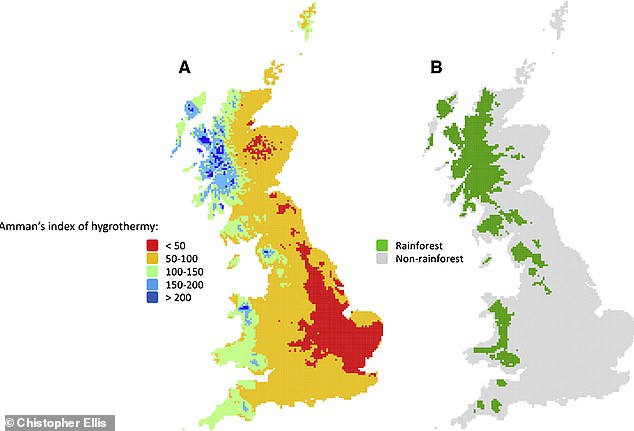
This map shows the areas of the UK that are considered rainforest, on the left the green areas show that 20 per cent of the country is suitable for rainforest growth
This means that thousands of years ago, one fifth of the country may have been made up of these fantastic environments.
However, today these stunning habitats are only present in 0.5 per cent of the UK and have been broken into a handful of tiny fragments.
In England this leaves the temperate rainforests covering only 69 square miles (178 square km) remaining.
Even Wistman’s Wood – the most famous and largest remaining rainforest in the UK – is only eight acres in total.
You can see for yourself just how far these habitats have declined by using the interactive map below.
Selecting the rainforest zone layer will reveal the areas of the UK where rainforests can grow.
The colours refer to the ‘hygrothermy’ of the area, a measure of temperature and moisture.
Darker purple colours show that the areas are ‘hyper-oceanic’ meaning they are extremely cold and wet all year.
Lighter blues signify an ‘oceanic’ area which receives slightly less water throughout the year.
However, everything within the coloured zone is considered to be a rainforest climate.
To understand just how little rainforest is left, turn off the rainforest zone layer and turn on rainforest fragments.
Zooming in, you will see tiny flecks of green marking out what remains of Britain’s lost rainforest.
For even more detail you can look at this interactive map below, which was created through a community effort to record the forest fragments.
Each green circle on the map is a fragment recorded by a member of the public.
To learn more, click on any of the circles to bring up additional information and pictures that have been recorded by the community.
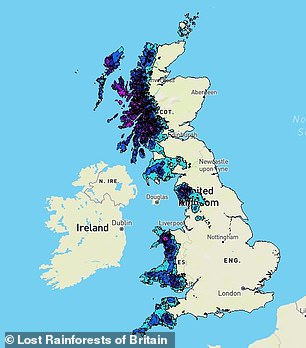
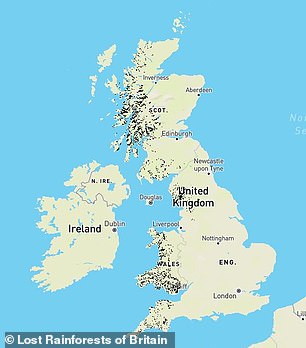
By comparing on the interactive map we can see how out of the large area where rainforest can grow (left), only fragments remain (right)
Guy Shrubsole, author of The Lost Rainforests of Britain, who created these maps, told MailOnline that this decline has been ongoing for centuries.
‘Britain’s a rainforest nation but tragically we have already cut down and degraded most of our temperate rainforests,’ he said.
‘Many of them were cut down long ago for fuel and to make way for agriculture, but some were felled as recently as the 20th century as a result of misguided forestry practices.’
What is worse, Mr Shrubsole explained, is that poor management is making it even harder for the forests to return.
Sheep and deer graze on young saplings, killing them off and leaving only old, frail trees behind.
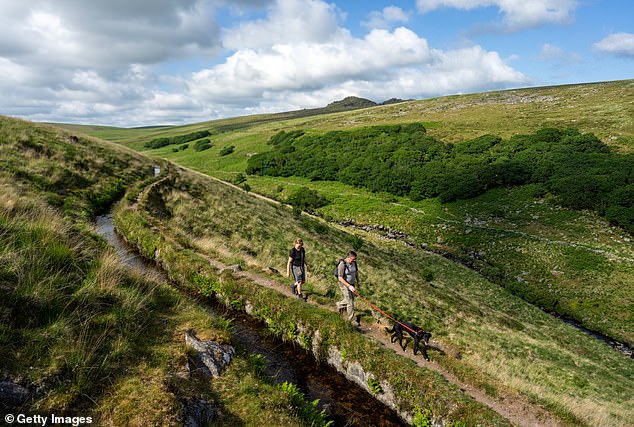
Now only fragments of forest survive like here in Dartmoor where the wind can blow through and reduce the humidity, threatening the rare species of plants
Mr Shrubsole said: ‘Deer, like sheep, pose a big threat to our temperate rainforests because they’re present in such large numbers, they’re stopping our rainforests from regenerating.
‘Sporting estates in Scotland have allowed deer numbers to get out of control, and there are as yet no natural predators like lynx or wolves.’
The invasive Rhododendron also poses a big threat as it grows fast in the wet West of Britain and smothers low-lying plants.
This doesn’t just stop the forests growing, but actually threatens to damage existing fragments.
Jon Stokes, director of trees, science, and research at the Tree Council, told MailOnline that grazing animals break up the protective layers of plant growth.
Mr Stokes said: ‘Lower shrubs baffle the wind so it doesn’t get in, this increases the humidity which is what you want.
‘If there’s too much grazing removing the lower vegetation and allowing air to move freely then that’s bad.’
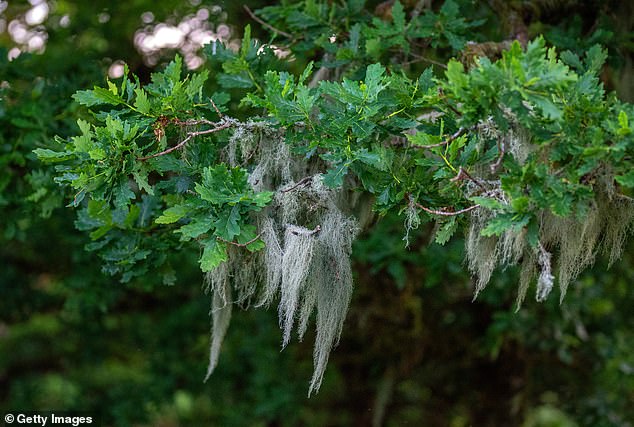
Temperate rainforests are the jewels in the crown of the UK’s biodiversity and are home to species found nowhere else, like this rare Horsehair lichen seen in Wistman’s Wood, Dartmoor
The loss of these precious woodlands is particularly troubling for the UK’s biodiversity.
Mr Stokes says that ancient woodlands like the temperate rainforests are ‘the jewel in our crown’ when it comes to preserving native species.
Temperate rainforests are particularly important for preserving native mosses and lichens which can be found almost nowhere else in the world.
Species like Tree Lungwort need the high humidity and cold temperatures only found in temperate rainforests to survive.
To see for yourself how important they are, turn on the Mosses, Liverworts, and Lichens layers on the first interactive map.
This records sightings of rare ectophyte species across the UK.
You can see that the dots representing the sightings are almost exclusively found in or near the remaining fragments of temperate rainforest.
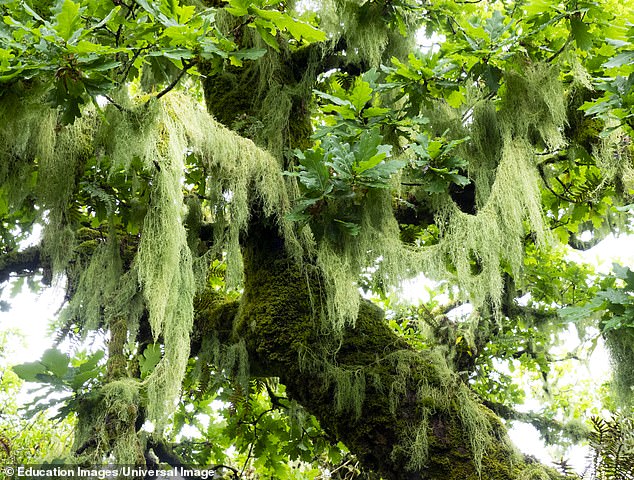
Beard Lichen, shown here in Devon on the South West coast of England, can only survive where there is enough moisture in the air, meaning that it cannot survive thrive beyond the temperate rainforest
Temperate rainforests also provide flood protection by absorbing vast amounts of water and sequester massive amounts of carbon dioxide.
Yet, Mr Smith of The Wildlife Trusts also thinks that there is something less tangible but equally vital at stake.
‘People forget that these are part of our landscape because they are not used to seeing these things, but they are an important part of our culture and history’, says Mr Smith.
‘They are the backdrop for the legends of King Arthur and the inspiration for Lord of the Rings.
‘I think people need to remember what we used to have and really demand that we have it back.’
While the situation may look bleak, there are some hints of hope for the future of these lost rainforests.

The temperate rainforests are the backdrop for Arthurian legends like the tale of Gawain and the Green Knight which recently became a film staring Dev Patel
In November of last year, the government published the first ever plan to recover England’s temperate rainforests.
The Nature and Climate Fund promised to invest up to £750,000 in research for improving resilience and management of temperate rainforests.
The strategy also includes a pledge to reduce pressure from deer grazing and to protect and restore these environments.
But, while campaigners have welcomed the plan as a critical step forward, they claim that it could go further.
The plan currently lacks any legally binding commitments to improve conservation or a guarantee of additional funding,
Mr Shrubsole says: ‘There’s much more that still needs to be done: the Government’s strategy lacks a clear goal – I think we should be aiming to double the size of England’s temperate rainforests by mid-century.
‘And we need a clear commitment from Ministers that they’ll be protecting more of these precious places as Sites of Special Scientific Interest and taking action to eradicate rhododendron.’

